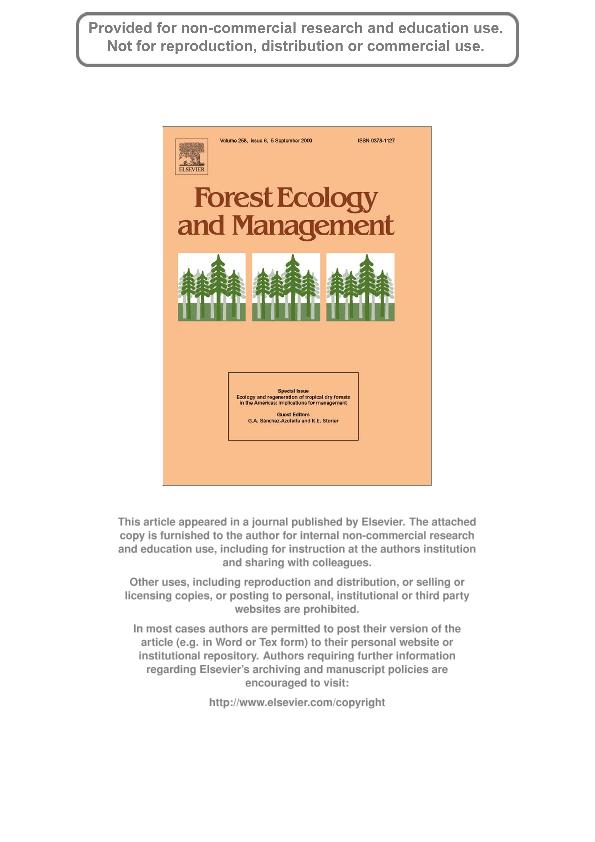Mostrar el registro sencillo del ítem
dc.contributor.author
Gasparri, Nestor Ignacio

dc.contributor.author
Grau, Hector Ricardo

dc.date.available
2019-06-11T15:25:25Z
dc.date.issued
2009-10
dc.identifier.citation
Gasparri, Nestor Ignacio; Grau, Hector Ricardo; Deforestation and fragmentation of Chaco dry forest in NW Argentina (1972-2007); Elsevier Science; Forest Ecology and Management; 258; 6; 10-2009; 913-921
dc.identifier.issn
0378-1127
dc.identifier.uri
http://hdl.handle.net/11336/77935
dc.description.abstract
The sustained increase in the global food demand has favoured the recent expansion of industrial agriculture into neotropical dry forest ecosystems, with resulting changes in their extent and spatial configuration. Based on Landsat satellite images, we analyzed changes in forest cover and landscape configuration over an area of 600 by 100 km located in NW Argentina (Tucuma´n and Salta provinces) in four periods between 1972 and 2007. The study area, one of the most active deforestation frontiers of South American dry forest, was divided into six relatively homogeneous sectors in terms of land property structure and biophysical characteristics. During the study period 1.4 millions hectares of dry forest were cleared. Deforestation started in the 1970s as a result of technological changes and increasing rainfall; continued (with spatial and temporal fluctuations) during the 1980s and 1990s in association to the
sustained global demand of soybean, and was accelerated (to ca. 100,000 ha year_1) between 2001 and 2007 following the global increase in commodity prices, and the national peso devaluation. We described the landscape structure using eight landscape indices, summarized as one synthesis value: the Euclidian distance across the seven dimensions from a theoretical non-fragmented situation. In areas with soil limitations deforestation resulted in relatively stable, highly fragmented landscapes. In
contrast, the sites with regional coarser-scale limitations (rainfall), deforestation produced a less fragmented landscape where agriculture concentrates in sites with high rainfall. Sites with no limitations for agriculture tend to a largely deforested landscape with few small and poorly connected forest patches. The land properties size seems to influence some indices of fragmentation, but the synthetic index of fragmentation suggests an overall convergence of fragmentation patterns towards a
similar configuration across different biophysical and land tenure conditions
dc.format
application/pdf
dc.language.iso
eng
dc.publisher
Elsevier Science

dc.rights
info:eu-repo/semantics/openAccess
dc.rights.uri
https://creativecommons.org/licenses/by-nc-sa/2.5/ar/
dc.subject
Chaco
dc.subject
Deforestation
dc.subject
Fragmentation
dc.subject
Land Use Change
dc.subject.classification
Otras Ciencias Biológicas

dc.subject.classification
Ciencias Biológicas

dc.subject.classification
CIENCIAS NATURALES Y EXACTAS

dc.title
Deforestation and fragmentation of Chaco dry forest in NW Argentina (1972-2007)
dc.type
info:eu-repo/semantics/article
dc.type
info:ar-repo/semantics/artículo
dc.type
info:eu-repo/semantics/publishedVersion
dc.date.updated
2019-06-10T13:42:48Z
dc.journal.volume
258
dc.journal.number
6
dc.journal.pagination
913-921
dc.journal.pais
Países Bajos

dc.journal.ciudad
Amsterdam
dc.description.fil
Fil: Gasparri, Nestor Ignacio. Consejo Nacional de Investigaciones Científicas y Técnicas. Centro Científico Tecnológico Conicet - Tucumán; Argentina
dc.description.fil
Fil: Grau, Hector Ricardo. Consejo Nacional de Investigaciones Científicas y Técnicas. Centro Científico Tecnológico Conicet - Tucumán; Argentina
dc.journal.title
Forest Ecology and Management

dc.relation.alternativeid
info:eu-repo/semantics/altIdentifier/doi/https://dx.doi.org/10.1016/j.foreco.2009.02.024
dc.relation.alternativeid
info:eu-repo/semantics/altIdentifier/url/https://www.sciencedirect.com/science/article/pii/S0378112709001352?via%3Dihub
Archivos asociados
